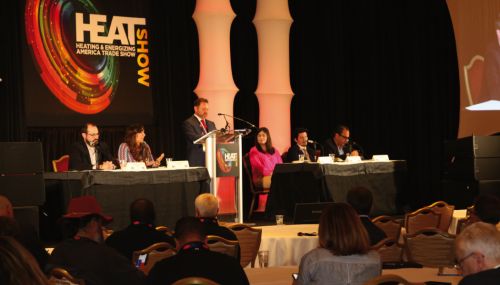All
New England Grid Needs Broader Market Changes to Address Fuel Security
by Ed Burke, Dennis K. Burke Inc.

In a region that is already fuel-constrained, the lack of regional energy infrastructure in the Northeast has residents paying some of the highest electricity rates in the country. Now, New England’s grid could be at risk of losing two of its major energy sources at the same time.
In March, Exelon Corp. announced a full shutdown of the Mystic Generating Station in Everett, Mass., a combination of oil and natural gas generators with about 1,700 megawatts of winter capacity. Without a region-wide bailout, the plant and its generators would shut down in 2022.
Soon after, the nonprofit regional grid operator ISO New England (ISO-NE) responded with an urgent request to the Federal Energy Regulatory Commission (FERC).
The Mystic plant gets all of its gas from a single LNG import terminal in Everett. If Mystic were to close, this terminal would lose its largest customer, New England could also lose the liquefied natural gas terminal that supplies it, and there could be a serious risk for blackouts during the winter months, posing “unacceptable fuel security risks.”
FERC’s Ruling
In July, FERC heard a request for a tariff waiver in order to save the Mystic plant from retirement. Tariffs are the approved terms and conditions by which generators, utilities and grid operators provide service.
FERC rejected the request in a 3-2 vote, writing that ISO-NE’s request is too broad, but its fuel security concerns are valid.
The decision recognized ISO-NE’s concerns about the need to rescue the Mystic power plant, but rejected the grid operator seeking a waiver from its regional tariff system based on fuel security concerns.
FERC did leave the door open though. Instead of the waiver approach, the federal agency gave ISO-NE an alternative regulatory path. They gave New England’s power grid operator until the end of August to come up with a short-term recovery proposal to bail out the pair of uneconomical natural gas-fired generators. They then gave them until July 2019 to develop a long-term approach to fuel security in the region.
The Status Quo
In April, the U.S. Energy Information Administration ranked state electricity rates. Massachusetts has the second highest residential electricity rates in the nation, while Connecticut ranks fourth, Rhode Island is fifth, New Hampshire ranks sixth, New York is seventh, Vermont eighth, Maine tenth, and New Jersey comes in at twelfth.
In a 2017 report by the U.S. Chamber of Commerce’s Institute for 21st Century Energy, the Energy Institute asks the question: “What if pipelines aren’t built into the Northeast?” The report contends that without additional pipeline infrastructure in the Northeast, New England could lose almost 23,000 jobs and about $2 billion in state GDP.
“As the regulatory and price environment continues to encourage the use of natural gas, Northeast states will find themselves increasingly starved of the energy needed to power the economy and keep the lights on,” said Karen Harbert, president and CEO of the Energy Institute. “Our analysis demonstrates that there is simply not enough capacity to meet demand, and families, consumers, and businesses will all pay the price.”
Filling the Energy Gap
When temperatures dropped to historic lows the day after Christmas, we turned to burning oil for as much as a third of our electricity. Massachusetts used two million barrels of oil in just 13 days during the December/January cold snap, according to the Mass Coalition for Sustainable Energy. The report also noted that we were just two to three days away from running out of oil too.
Are Pipelines Really Needed?
In mid-July, the Senate Committee on Energy & Natural Resources held a hearing on interstate natural gas and electricity infrastructure, with a focus on this winter’s 12 days of frigid weather.
Maine Senator Angus King, who is a former FERC Chairman, questioned the need to make such significant capital investments just to deal with “12 days” of winter demand from power generators. The Senator suggested a more diverse approach to the region’s energy needs might be better for ratepayers. This includes a greater focus on storage, demand-response, distributed energy, and overall system efficiency.
Former FERC Chairman Joseph Kelliher agreed with the Senator, and testified that natural gas pipeline capacity in New England and New York is adequate for all but “12 days” of the year. This limited demand, he noted, has discouraged major investment in regional pipeline projects. Kelliher said the “correct economic solution” is to allow power generators to store fuel oil on-site that can be used to generate electricity during peak demand. The issue with that, he pointed out, was that some of states in the region have placed limits on such “dual-fuel” facilities over air quality concerns.
Stakeholders continue to debate which fuels should be part of the region’s energy mix. Some believe the region needs more pipelines, while others say pipelines would stifle renewables. Some think nuclear is part of the solution, and others don’t. Obviously, there are a lot of issues that have yet to be worked out in New England.
Related Posts
 Spotlight Sessions Illuminate Opportunities and Challenges
Spotlight Sessions Illuminate Opportunities and Challenges
Posted on September 19, 2025
 NEFI Testifies on RFS Changes Affecting the Heating Oil Industry
NEFI Testifies on RFS Changes Affecting the Heating Oil Industry
Posted on August 18, 2025
 From Retailer to Representative: Chris Keyser’s Road to the Vermont State House
From Retailer to Representative: Chris Keyser’s Road to the Vermont State House
Posted on June 16, 2025
 Northeast Working Group for Industry Principles Gets to Work
Northeast Working Group for Industry Principles Gets to Work
Posted on May 8, 2025
Enter your email to receive important news and article updates.
